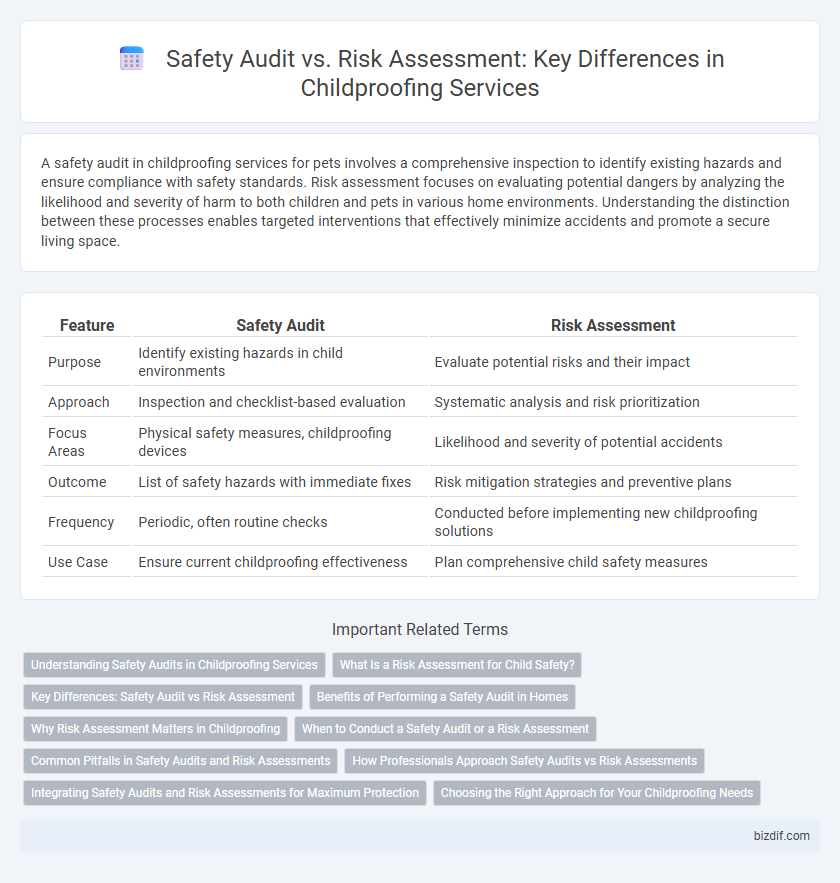A safety audit in childproofing services for pets involves a comprehensive inspection to identify existing hazards and ensure compliance with safety standards. Risk assessment focuses on evaluating potential dangers by analyzing the likelihood and severity of harm to both children and pets in various home environments. Understanding the distinction between these processes enables targeted interventions that effectively minimize accidents and promote a secure living space.
Table of Comparison
| Feature | Safety Audit | Risk Assessment |
|---|---|---|
| Purpose | Identify existing hazards in child environments | Evaluate potential risks and their impact |
| Approach | Inspection and checklist-based evaluation | Systematic analysis and risk prioritization |
| Focus Areas | Physical safety measures, childproofing devices | Likelihood and severity of potential accidents |
| Outcome | List of safety hazards with immediate fixes | Risk mitigation strategies and preventive plans |
| Frequency | Periodic, often routine checks | Conducted before implementing new childproofing solutions |
| Use Case | Ensure current childproofing effectiveness | Plan comprehensive child safety measures |
Understanding Safety Audits in Childproofing Services
Safety audits in childproofing services involve systematic inspections to identify potential hazards in a child's environment, ensuring compliance with established safety standards. These audits focus on verifying the effectiveness of installed safety measures such as cabinet locks, outlet covers, and stair gates. By documenting findings and recommending improvements, safety audits help create a safer living space tailored to a child's specific needs.
What Is a Risk Assessment for Child Safety?
A risk assessment for child safety identifies potential hazards in a child's environment, evaluates the likelihood and severity of harm, and recommends measures to mitigate those risks. Unlike a general safety audit, which reviews compliance with safety standards, a risk assessment focuses specifically on anticipating and preventing accidents or injuries in settings like homes, schools, and playgrounds. This proactive approach helps ensure a comprehensive childproofing plan tailored to unique risks.
Key Differences: Safety Audit vs Risk Assessment
A safety audit involves a systematic examination of existing safety protocols and compliance with standards to identify gaps in childproofing measures. In contrast, a risk assessment evaluates potential hazards and the likelihood of harm to children, focusing on preventive strategies tailored to specific environments. Key differences include the audit's emphasis on current safety performance versus the assessment's proactive approach to identifying and mitigating future risks.
Benefits of Performing a Safety Audit in Homes
Performing a safety audit in homes identifies specific hazards and ensures childproofing measures are effectively implemented, reducing the risk of accidents. A safety audit provides a thorough analysis of potential dangers, allowing for targeted interventions tailored to a child's developmental stage. This proactive approach enhances overall home safety, promoting peace of mind for parents and caregivers.
Why Risk Assessment Matters in Childproofing
Risk assessment matters in childproofing because it identifies specific hazards in a child's environment, enabling tailored prevention strategies that a general safety audit might overlook. Unlike safety audits, which provide a checklist overview, risk assessments analyze the likelihood and severity of potential injuries, ensuring more effective and proactive child protection. Prioritizing risk assessments reduces accidents and creates a safer living space by addressing unique risks relevant to the child's age, behavior, and environment.
When to Conduct a Safety Audit or a Risk Assessment
Conduct a safety audit regularly or after any significant changes in the home environment to ensure all childproofing measures comply with current safety standards. Perform a risk assessment before introducing new furniture, toys, or equipment to identify potential hazards specific to the child's developmental stage. Both processes are crucial when moving to a new residence to create a safe living space tailored to prevent accidents effectively.
Common Pitfalls in Safety Audits and Risk Assessments
Safety audits often fall short by overlooking specific child-related hazards and failing to involve caregivers in the evaluation process, which can lead to incomplete safety measures. Risk assessments commonly underestimate the dynamic nature of children's behavior and environmental changes, resulting in outdated or insufficient mitigation strategies. Both processes require continuous updates and tailored approaches to address unique household risks and ensure effective childproofing outcomes.
How Professionals Approach Safety Audits vs Risk Assessments
Professionals conducting safety audits in childproofing systematically evaluate compliance with established safety standards, ensuring all child hazards are identified and mitigated. Risk assessments involve analyzing potential hazards' likelihood and impact, allowing experts to prioritize preventative measures based on severity and probability. This methodical distinction enables childproofing specialists to tailor interventions effectively, combining objective inspections with dynamic risk evaluations.
Integrating Safety Audits and Risk Assessments for Maximum Protection
Integrating safety audits and risk assessments ensures comprehensive childproofing by identifying hazards and evaluating potential risks in homes or childcare environments. Safety audits systematically inspect physical elements like furniture stability and electrical outlets, while risk assessments analyze behavior patterns and environmental factors that could lead to accidents. Combining these methodologies enhances preventive strategies, creating safer spaces tailored to children's unique needs.
Choosing the Right Approach for Your Childproofing Needs
A safety audit in childproofing involves a systematic inspection of your home to identify existing hazards and ensure compliance with safety standards, making it ideal for maintaining a safe environment. In contrast, a risk assessment evaluates potential dangers by analyzing the likelihood and impact of hazards specific to your child's behavior and developmental stage, providing a tailored safety strategy. Choosing the right approach depends on your goal: use a safety audit for comprehensive checks and a risk assessment for personalized risk management to effectively protect your child.
Safety audit vs Risk assessment Infographic

 bizdif.com
bizdif.com